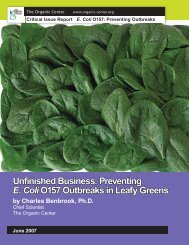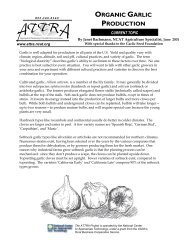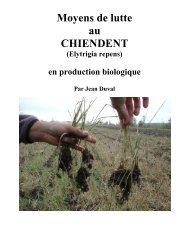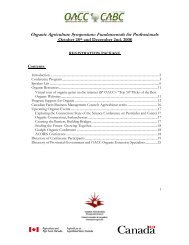Managing wild radish in feed grains
Managing wild radish in feed grains
Managing wild radish in feed grains
Create successful ePaper yourself
Turn your PDF publications into a flip-book with our unique Google optimized e-Paper software.
WHAT WAS DONE?<br />
The BOMP trial was conducted on two PEI farms.<br />
Both farms were <strong>in</strong>terested <strong>in</strong> test<strong>in</strong>g new weed<br />
management practices, and were <strong>in</strong> the early<br />
stages of adopt<strong>in</strong>g organic management. Early <strong>in</strong><br />
the year, <strong>wild</strong> <strong>radish</strong> (not <strong>wild</strong> mustard) was<br />
identified as the problem weed <strong>in</strong> these fields.<br />
The BOMP plots were managed with practices<br />
designed to control <strong>wild</strong> <strong>radish</strong>. Table 1 lists<br />
examples of BOMPs that may be useful for <strong>wild</strong><br />
<strong>radish</strong> control, as determ<strong>in</strong>ed through a literature<br />
review. For this project, the BOMPs chosen<br />
comb<strong>in</strong>e several techniques <strong>in</strong>clud<strong>in</strong>g false seed<br />
bed technique, roll<strong>in</strong>g after tillage, <strong>in</strong>creas<strong>in</strong>g<br />
seed<strong>in</strong>g rate, and f<strong>in</strong>gerweed<strong>in</strong>g (Table 2).<br />
The NORM plots were managed with the farmers’<br />
normal practices.<br />
The false seed bed technique is used early <strong>in</strong> the<br />
grow<strong>in</strong>g season to stimulate weed germ<strong>in</strong>ation.<br />
The field is cultivated twice. The first cultivation<br />
encourages weed germ<strong>in</strong>ation, and the second<br />
(7-10 days later) kills off any weeds that emerge.<br />
The crop is planted soon after <strong>in</strong>to this “stale”<br />
seedbed. This operation is best done <strong>in</strong> the<br />
morn<strong>in</strong>g on a sunny day so uprooted weeds will<br />
dry out and not re-establish. Higher seed<strong>in</strong>g<br />
rates will make the crop more competitive, and<br />
compensate for crop losses due to post-emergent<br />
f<strong>in</strong>gerweed<strong>in</strong>g.<br />
Table 1. Best Management Practices for Wild Radish Control 2,3<br />
Prevention<br />
• Use clean seed<br />
• Scout your field and rogue at flower<strong>in</strong>g <strong>in</strong> the first year weeds are spotted (Don’t wait until next year!)<br />
• Use a modified swather to reduce seed production by cutt<strong>in</strong>g the tops of weeds above the gra<strong>in</strong> <strong>in</strong> July<br />
Diversify Crop Rotations<br />
• Longer term crops (pasture, forage)<br />
• Crops that develop rapidly with full canopies<br />
• Sturdy crops that allow aggressive mechanical weed<strong>in</strong>g (potatoes and turnips)<br />
• No-till seed<strong>in</strong>g of fall seeded crops (w<strong>in</strong>ter rye, hairy vetch) to m<strong>in</strong>imize seedbank disturbance<br />
• Modify accord<strong>in</strong>g to field history and future needs<br />
Primary Cultivation<br />
• In a clean field: M<strong>in</strong>imize <strong>in</strong>version/vertical mix<strong>in</strong>g<br />
• In a weedy field:<br />
- Maximize shallow tillage before or at the first true leaf stage (<strong>in</strong> top 5 cm)<br />
- Mow green manures to form a mulch, then till <strong>in</strong>to soil before sow<strong>in</strong>g (use oats, barley, legumes, rye, hairy<br />
vetch, red clover)<br />
- Use smother crops (oats, barley, rye, vetch)<br />
- Include a period of fallow<br />
Secondary Cultivation<br />
• Tillage should be shallow, above 5 cm<br />
• Promote germ<strong>in</strong>ation of weed seeds by:<br />
- Pack or roll after tillage to ensure good contact between the weed seed and soil<br />
- Use shallow cultivation to alternate light/dark, which can trigger germ<strong>in</strong>ation<br />
• Create false seed bed then follow with a stale seed bed (repeated pack<strong>in</strong>g and shallow tillage):<br />
- Create <strong>in</strong>itial seedbed with 1 cm tillage<br />
- Promote weed germ<strong>in</strong>ation<br />
- Cultivate/harrow to kill weeds 2–3 times<br />
- Drill crop 4-7 days after first tillage (perhaps longer for fast germ<strong>in</strong>at<strong>in</strong>g crop seeds)<br />
• Bl<strong>in</strong>d harrow<strong>in</strong>g at the pre-emergent or post-emergent (3-5 leaf) stage for cereals that are deeply drilled and robust<br />
• After drill<strong>in</strong>g the crop, control weeds with thermal/flame weed<strong>in</strong>g, cha<strong>in</strong> harrow<br />
• Frequent mow<strong>in</strong>g can prevent weed seed set<br />
Sow<strong>in</strong>g Crop<br />
• Increase seed<strong>in</strong>g rates by 10-20% and cross seed with 2 passes to <strong>in</strong>crease crop competitiveness and compensate<br />
for mechanical weed<strong>in</strong>g losses<br />
• Accuracy with drill<strong>in</strong>g is important to ensure no gaps occur between the runs<br />
• If possible, use wide rows with twice the normal seed<strong>in</strong>g rate <strong>in</strong> each row to allow aggressive <strong>in</strong>terrow cultivation<br />
Harvest<strong>in</strong>g<br />
• Capture weed seeds with a chaff collector on comb<strong>in</strong>e<br />
Elim<strong>in</strong>at<strong>in</strong>g Autumn Flushes<br />
• Seed<strong>in</strong>g a w<strong>in</strong>ter cereal or a cover crop us<strong>in</strong>g cultivation practices described above where possible<br />
• Underseed<strong>in</strong>g a forage crop with the spr<strong>in</strong>g crop will elim<strong>in</strong>ate tillage and will compete with weeds <strong>in</strong> the fall<br />
2

















